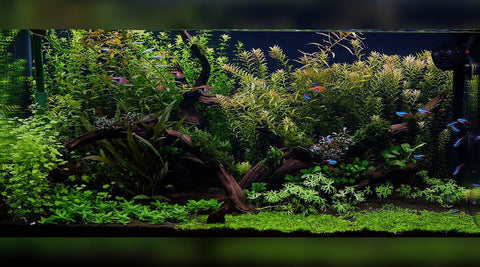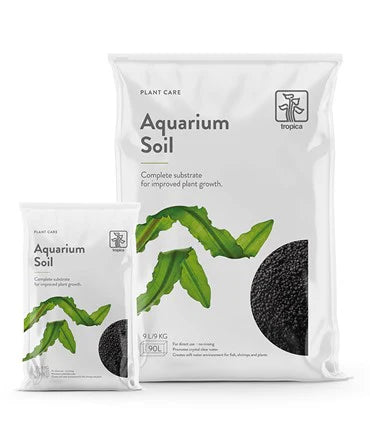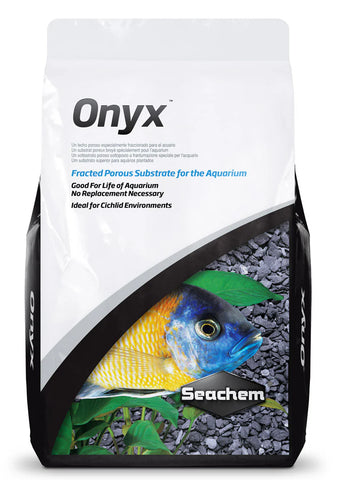Table of Contents
It is really hard to confirm that soil is the best of all. Even when you do gardening, there are still thousands of types of soil for you to consider as not all the plants suit all kinds of soil. So do aquarium plants. They are the species growing underwater and in captivity, which make the planting and caring more challenging than usual. Hence, before we have a proper answer for this question, it is good to get a glimpse of common types of substrates and their interaction with live aquatic plants.
In this article, we will list out some relevant key issues which we believe support you a lot in not only choosing the appropriate substrate but also creating and maintaining your desired planted tank.

What is the aquarium substrate? And, does my planted tank need it?
Aquarium substrate refers to the material used on the bottom of your fish tank/ container. It can be anything from sand, gravels, pebbles, regular soil to aquarium-designated soil (aquarium soil for short). These types of substrates are not the “strangers” to aquarists, yet choosing the appropriate one is sometimes a tough consideration. This is because each type of substrate serves specific purposes (depending upon aquarists’ using intentions) and affects the tank community in many aspects (from water chemistry, filtration to the well-being of aquarium’s inhabitants).
Generally, most aquarists aim at aesthetics when considering the substrate for their tanks. That said, this is not the only benefit substrate can do for aquariums especially, in the case such aquarium contains live aquatic plants. Substrate then turns out to be a very important factor because it could help provide nutrients for live plants as well as anchor them firmly.
Read till the line, you might think the answer for the later question (does my planted tank need aquarium substrate?) must be yes. In fact, there are many exceptions showing that live aquarium plants could survive without substrates. If you do some quick searches, you will find a lot of examples like java moss, Marimo Moss Balls, hornwort, anubias, water lettuce, etc. They are species that require very little to no nutrients to grow or absorb fertilizers through water columns instead of root systems. This confirms the fact as well as reveals the first pivotal condition to find out the best substrate for aquatic plants: aquarium plants you intend to grow will decide the need and the type of substrates for your planted tanks.
Which substrate is the right type for my tank?
In order to answer the question thoroughly, we need to go through the list of common substrates which are highly recommended by the aquarium community and their pros and cons respectively.
Sand is fine grade rock minerals which is best known for the low maintenance and cleanest substrate of all. It is too compact to let any particle penetrate the surface. Hence, if your planted tank contains fish/ invertebrates, sand could be the first to think of as it helps the cleaning of leftover food easier than ever. All you need to do is remove the dirt from the top of aquarium substrates.

(Image of several types of sand substrate)
However, sometimes the advantage may appear to be a disadvantage concerning live aquatic plants (especially, those are heavy root feeders and take in nutrients only through roots). The density turns out to be the cause which prevents plants’ roots from growing and spreading. Further, sand is an inert substrate which has no nutritional value for aquatic plants. Covering your tank bottom with a layer of sand means you have to rely on other alternatives to provide nutrients for your lovely live plants such as, root tabs or liquid fertilizers. Nonetheless, sand is still not an ideal solution for heavy root feeders.
Like sand, gravel is an inert substrate (which requires you to provide minerals and nutrients to plants through other means such as root tabs or liquid fertilizers). However, gravel is somehow preferable to sand mainly thanks to the size and density.
Gravels are grains but much larger (above 2.0 mm). The size makes them less compact which is vital for the plant's roots to grow and extend, particularly those having thin and fragile root systems. Moreover, it stimulates the circulation of oxygen, an important activity required for robust development of plants, and gas exchange which prevents harmful gas accumulating and killing the aquatic plants.

(Image of fine gravels and coarse gravels)
The only downside which may find you annoying is cleaning. In the aquarium market, there are a variety of gravels from fine to something coarser. If you opt for the medium-graded/ coarse gravels, it is not a big deal. Since the holes they create in between are large enough for you to spot the leftover food and vacuum. However, if your chosen gravels are fine and small, it surely takes you much time and effort to remove the dirt. Worse scenarios happen when you are not diligent in performing the cleaning. Your tank has to welcome the increase of ammonia or nitrite levels in the water and algae bloom as a result.
Baked clay substrates
It is another inert substrate that could be said superior to sand and gravels thanks to better porosity (capacity to provide more surface area for beneficial bacteria to develop) and higher CEC values (capacity to attract and hold valuable nutrients from the environment and readily provide them to aquatic plants).

(Image of a baked clay substrate product)
Nonetheless, be aware that baked clay substrate itself does not contain nutritional value at all, which means your aquarium plants still need nutrients in other forms to survive and thrive. Besides, subject to the specific baked clay-based products and the manufacturers that the use of it is preferable or inconvenient.
Regular soil, in this situation, is understood as topsoil and potting soil which are classified as depleting substrates containing essential nutrients for plants and decomposing slowly with time. Topsoil is the soil you can easily find in the garden, the top layer of dirt which includes mostly sand or gravel and compost or other organic materials; while potting soil comprises the like but largely used for growing plants in containers/ pots.
Generally speaking, regular soil is the true mate of all plants as it has the appropriate texture for roots to attach to and develop. Further, the co-living microorganisms in soil make it a good nutrient source to nurture and keep plants robust. However, it is really not an ideal option for an aquatic environment due to many reasons.
- Regular soil is a combination of superfine and very light particles which, in normal state (not fully submerged in water), could not be more perfect for plants; yet a disaster for aquarium environment/ aquascape hobby, especially if handled by an amateur. It is easily stirred by fish/ invertebrates, clouding the water and causing muddy mess. Although some experienced aquarists suggested that you fix the problem by covering it with a thin layer of gravel, the situation seems not to be better. Hence, if you are considering this type of substrate, we truly recommend you to not go for it.
- Regular soil does change water parameters/ chemistry. It is regarded as a chemical active. Thus, if you don’t know exactly the components contained therein, the advice is you should not layer it on your tank’s bottom. Live aquarium plants rely on many factors to grow, among others, water parameters. They are also the key deciding the survival of plants. If such parameters are not met the requirements, your plants will die out even if you provide them with good regular soil.
- Cleaning is another aspect that makes regular soil less appealing. You cannot avoid that, especially if you raise fish together with plants. Water change and tank clean-up are important steps to keep your aquarium in a proper state for fish to live happily, and plants to grow robustly. However, this action surely messes up everything that has once been established well. Soil gets stirred then water gets dirty. That has not mentioned nutrients in regular soil become depleted eventually, which means the substrate must be reinvigorated periodically. Way or another, you have to touch the substrate and believe us, the process takes much much of irritation.
Aquarium soil
If other types of substrates have several cons here and there, aquarium soil is nearly a flawless option for aquatic plants.

(Image of aquarium soil)
Aquarium soils are baked, regular soils that form granules. The substrate takes all advantages of the other substrates yet excludes all disadvantages you may find in the others. Simply to say, it contains nutrients required for plants which is the plus and also the key role of regular soil substrate, while remaining in a shape that makes the cleaning and root growth processes easier. If we have to discuss its drawback, it may be about… the price. Aquarium soil is quite expensive. Although it is very very good for live aquarium plants, particularly heavy root feeders, it is really costly. Moreover, like regular soil, aquarium soil will become depleted of nutrients eventually which requires the regular revival of substrate. This feature somehow increases the cost you must bear if layering aquarium soil on your tank’ bottom.
After all, What is the best substrate for aquarium plants?
Back to the main question, the best substrate for aquarium plants is the one that allows your plants to thrive robustly and the maintenance of it less complicated. To identify that substrate, you can count on several points below:
- Live aquatic plants: What are the live aquatic plants you are going to plant in your aquarium? As we discussed at the beginning, answering this question helps you find out the proper substrate for your planted tank. The way your plants grow and thrive decides the need and the type of substrate. Although we have gone through the list of common substrates in the aquarium trade and found out that aquarium soil appears to be most suitable, it is unnecessary if your chosen aquatic plant is moss or banana bulb. That means you can totally go for the less expensive yet effective material.
- Cleaning issues: If you notice, we’ve mentioned the issue a lot in this article. This is because each time the process occurs, it will affect the whole tank community. As you may know, live aquatic plants and fish are very sensitive to even a minor change. Cleaning means you have to touch a little bit here and there and whether you want to or not, the process will cause some changes to the tank community. If it is performed improperly, the cleaning could be more harmful than good.
- Water chemistry: Some substrates may not alter the water chemistry in your tank (e.g. inert substrates), some do. The important thing is whether you can control such changes or not. Generally, you can find the relevant information on the product’s label. The awareness helps you have a good preparation in advance to monitor all elements required for the development of the community.
- Aesthetics: Last but not least, if you aim at a beautiful aquarium, everything you put therein must be coherent. For example, creating moss carpet may not need aquarium soil, gravel can do; or if your target is a jungle view, a little bit of contrast between the green and dark black color of substrate would help you achieve what you want.
In conclusion, our recommendation for beginners is that you go for the easy-to-care-for plants first to get experience before starting with something more difficult. With the low-maintenance plants, you may not need to buy the expensive substrate but still grow them strongly and healthily. Gravel could be a good start in this case. If you are confident in your skills and want to try difficult-to-care for species, you could consider nutrient-rich bases branded Fluval Stratum or Ecocomplete. One will know what is the best for them only if they get started. Let yourself experience then find out the appropriate substrate for your own tank and don’t forget to share with us your ‘fun journey’.



























